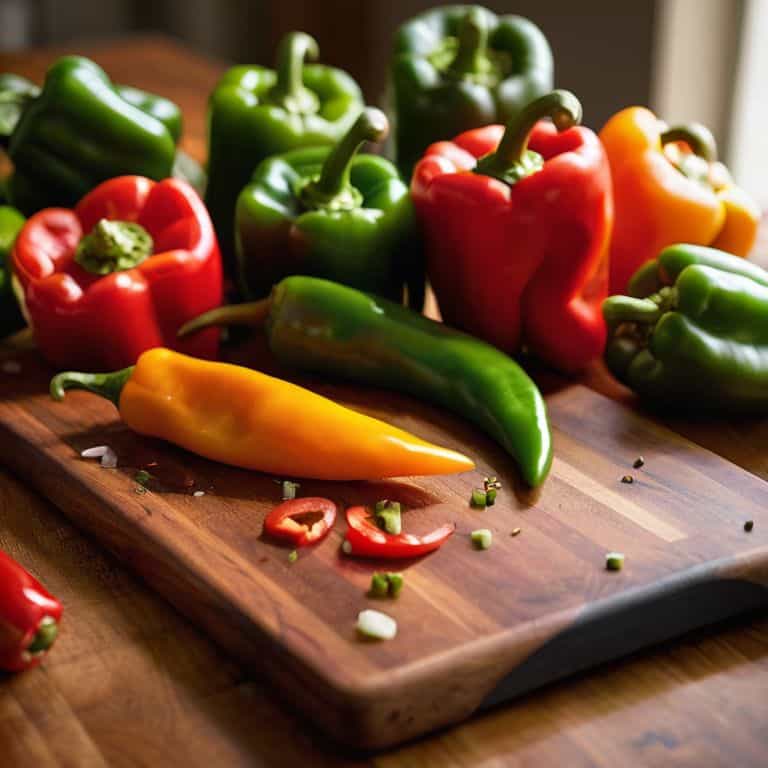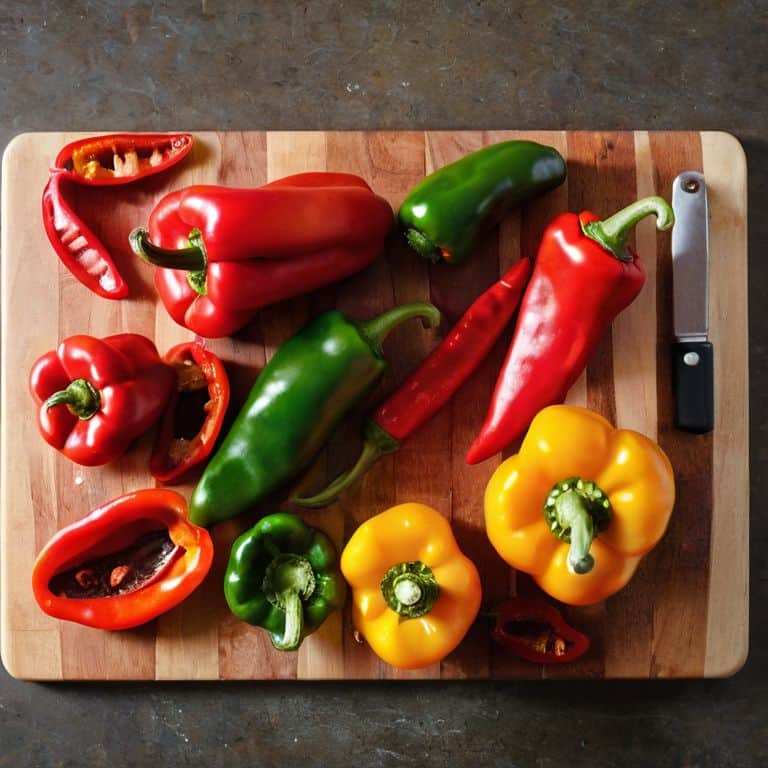I still remember the day I realized that making hot sauce wasn’t just about throwing a bunch of peppers into a blender. I was experimenting with different recipes, trying to find the perfect balance of heat and flavor, and I stumbled upon the question that would change everything: what peppers to use for hot sauce. It’s a question that seems simple, but can be overwhelming, especially with all the options out there. I mean, who hasn’t stood in front of the pepper display at the farmer’s market, wondering which ones to choose?
As someone who’s passionate about crafting unique flavors, I’m excited to share my knowledge with you. In this article, I’ll give you the lowdown on my favorite peppers to use when making hot sauce, and I’ll show you how to unleash the flavor of each one. You’ll learn how to choose the right peppers, how to prepare them, and how to blend them into a sauce that’s tailored to your taste. My goal is to empower you to create your own signature hot sauce, one that’s made with love and care, and that will elevate your dishes to the next level. So, let’s get started on this spicy journey and explore the amazing world of peppers, shall we?
Table of Contents
Guide Overview: What You'll Need

Total Time: 1 hour 30 minutes
Estimated Cost: $10 – $20
Difficulty Level: Easy
Tools Required
- Blender (or food processor)
- Fine mesh strainer
- Glass bottles (for storing hot sauce)
Supplies & Materials
- Jalapeno peppers for mild heat
- Serrano peppers for medium heat
- Habanero peppers for extreme heat
- Vinegar (apple cider or white wine)
- Salt
- Garlic (optional)
Step-by-Step Instructions
- 1. First, let’s talk about the foundation of a great hot sauce: the peppers. I’m a firm believer that experimenting with different varieties is key to finding your perfect blend. For me, it all starts with a trip to the local farmer’s market to see what’s in season. I love picking up a few pounds of _fresh, vibrant_ peppers to get my creative juices flowing.
- 2. Next, it’s time to _get familiar_ with your peppers. I like to start by slicing open a few different types to see what’s inside. You’ll want to take note of the heat level, as well as the flavor profile of each pepper. Some, like habaneros, will be super spicy, while others, like Anaheim peppers, will be milder. This is where the magic happens, and you start to envision your perfect hot sauce.
- 3. Now that you’ve got your peppers, it’s time to prep them for roasting. I like to toss mine with a bit of oil, salt, and my favorite spices, then spread them out on a baking sheet. Roasting brings out the natural sweetness in the peppers and adds a depth of flavor that’s hard to replicate. Just be sure to keep an eye on them, as you want them to be _tender, but not burnt_.
- 4. With your peppers roasted, it’s time to blend them into a puree. I use a combination of roasted peppers, garlic, and sometimes a bit of onion or carrot to add some extra flavor. The key here is to _taste as you go_, adjusting the seasoning and heat level to your liking. Don’t be afraid to add a bit of vinegar or citrus to brighten things up.
- 5. Once you’ve got your pepper puree, it’s time to add in your aromatics. This is where you can get really creative, adding in everything from _caramelized onions_ to smoked paprika. The goal is to create a rich, complex flavor profile that’ll make your hot sauce stand out from the crowd.
- 6. Now it’s time to bring everything together. I like to combine my pepper puree with a bit of vinegar, salt, and sometimes some extra spices, then simmer it all down until it’s thick and syrupy. This is the _most crucial step_, as it’s where all the flavors meld together and your hot sauce starts to take shape.
- 7. Finally, it’s time to bottle and enjoy your homemade hot sauce. I like to fill up a few glass jars, then store them in the fridge to allow the flavors to mature. There’s nothing quite like the feeling of _watching your friends and family enjoy_ something you’ve created from scratch. Just be warned: once you start making your own hot sauce, you’ll never go back to store-bought again.
What Peppers to Use for Hot Sauce

When it comes to crafting the perfect homemade hot sauce, the type of peppers you use can make all the difference. I’m a big fan of experimenting with different pepper varieties for hot sauce, as each one brings its own unique flavor profile to the table. From the smoky heat of chipotle peppers to the bright, fruity flavor of habaneros, the options are endless. By combining different peppers, you can create complex and interesting hot sauce flavor profiles that will elevate your dishes to the next level.
One of my favorite techniques for enhancing the flavor of my hot sauce is roasting peppers for hot sauce. This simple step can bring out the natural sweetness in the peppers and add a depth of flavor that’s hard to replicate with raw peppers. I also like to pay attention to the pepper heat levels for hot sauce, as this can greatly impact the overall character of the finished product. Whether you like it mild or wild, there’s a pepper out there that’s sure to fit the bill.
As you start to experiment with different peppers and techniques, you’ll begin to develop your own signature homemade hot sauce recipes. Don’t be afraid to think outside the box and try unusual pepper combinations for unique hot sauce flavors. Some of my favorite combinations include pairing sweet peppers with spicy ones, or mixing smoky peppers with bright, citrusy ones. The possibilities are endless, and the fun is in the experimentation.
Blending Heat Levels for Unique Flavors
Now that we’ve explored the amazing world of peppers, let’s talk about blending heat levels to create something truly unique. I love experimenting with different combinations to find that perfect balance of flavor and heat. For a smoky, slightly sweet hot sauce, I’ll often combine the earthy warmth of Anaheim peppers with the bright, fiery kick of habaneros.
By mixing and matching peppers with varying heat levels, you can craft hot sauces that are tailored to your taste buds. Don’t be afraid to get creative and adjust the ratios to suit your desired level of heat. Remember, it’s all about finding that sweet spot where the flavors meld together in perfect harmony. Trust me, the possibilities are endless, and the fun is in the experimentation!
Unlocking Pepper Varieties for Hot Sauce
Unlocking Pepper Varieties for Hot Sauce
I love experimenting with different pepper varieties to create unique hot sauce flavors. From the spicy kick of habaneros to the smoky depth of chipotles, each pepper brings its own character to the table. I’ve found that combining peppers can lead to some amazing flavor profiles – like pairing sweet, slightly smoky poblanos with the bright, fiery heat of fresno peppers. The key is to balance heat and flavor, so don’t be afraid to get creative and try out new combinations.
Pepper Perfection: 5 Tips to Ignite Your Hot Sauce
- Experiment with a variety of pepper types, from sweet and smoky to bold and blazing, to find the perfect balance for your hot sauce
- Don’t be afraid to blend different heat levels, from mild Anaheim to scorching Ghost Peppers, to create a unique flavor profile that’ll leave taste buds tingling
- Consider the flavor profile you want to achieve – fruity, earthy, or spicy – and choose peppers that’ll complement your vision, like the slightly sweet Poblano or the tangy Habanero
- Think beyond the pepper itself and explore how other ingredients, like garlic, onion, or citrus, can enhance or contrast with the pepper’s natural flavor and heat
- Remember, the key to an unforgettable hot sauce is harmony – so don’t just focus on the peppers, think about how all the ingredients will work together in perfect, spicy symphony
Key Takeaways for Crafting the Perfect Hot Sauce
Experiment with a variety of pepper types to find the perfect balance of heat and flavor for your hot sauce, from sweet and smoky to bold and incendiary
Blending different heat levels and flavor profiles can create a unique and complex hot sauce that elevates any dish, so don’t be afraid to get creative and try new combinations
Remember, the art of making hot sauce is all about experimentation and having fun, so don’t be discouraged if it takes a few tries to get it just right – and always use the freshest, locally-sourced ingredients you can find
The Pepper Principle
The right pepper can ignite a hot sauce, but it’s the combination of flavors, the balance of heat and sweetness, that sets your taste buds ablaze – and that’s where the magic happens, folks!
Tom Navarro
Unlocking the Perfect Blend

As we’ve explored the world of peppers for hot sauce, it’s clear that experimentation is key. From the subtle sweetness of Anaheim peppers to the smoky heat of Chipotles, each variety brings its own unique character to the table. By blending different heat levels and flavor profiles, you can create a hot sauce that’s truly one-of-a-kind. Whether you’re a fan of mild and tangy or bold and incendiary, the right combination of peppers can elevate your dishes and add a whole new dimension of flavor.
So as you embark on your own hot sauce-making journey, remember that the art of creation is just as important as the end result. Don’t be afraid to get creative and try new things – after all, that’s where the magic happens. With a little patience, practice, and experimentation, you’ll be crafting your own signature hot sauces in no time. And when you do, I want to hear about it! Share your favorite pepper combinations and hot sauce recipes with me, and let’s keep the conversation going. Happy fermenting, and I’ll catch you in the next post!
Frequently Asked Questions
What's the best way to balance heat and flavor when combining multiple pepper varieties for hot sauce?
For me, it’s all about harmony – I like to balance heat and flavor by pairing peppers that complement each other. Think sweet and smoky, or spicy and tangy. I’ll often combine a milder pepper like Anaheim with a hotter one like Ghost Pepper to create a depth of flavor that’s both spicy and nuanced. Experiment, taste, and adjust – that’s the key to unlocking your perfect blend!
Can I use sweet peppers, like bell peppers, to add depth to my hot sauce without making it too sweet?
Absolutely, sweet peppers can add amazing depth to your hot sauce. I like to use roasted bell peppers to bring a smoky sweetness without overpowering the heat. Just be sure to balance it out with some spicier peppers to avoid a too-sweet sauce. Trust me, it’s a game-changer!
How do I know when to use fresh peppers versus dried or smoked peppers for the best flavor in my homemade hot sauce?
For me, it’s all about the vibe I’m going for – fresh peppers add a bright, snappy flavor, while dried or smoked ones bring a deeper, richer heat. If I’m making a sauce with a lot of citrus or herbs, I’ll use fresh peppers to keep it lively. But if I’m going for a more robust, BBQ-inspired flavor, smoked peppers are the way to go.
